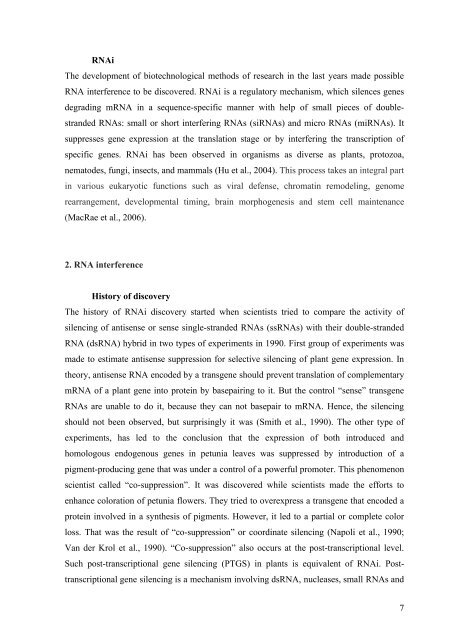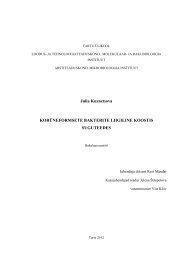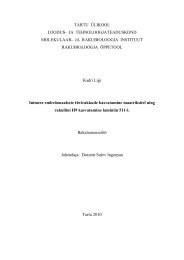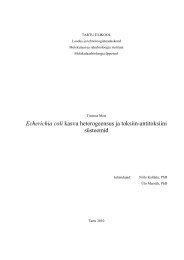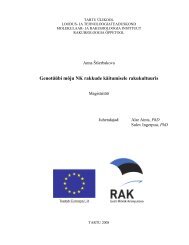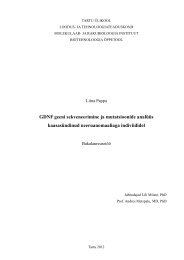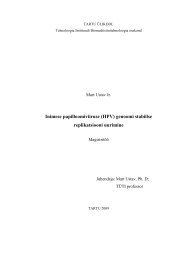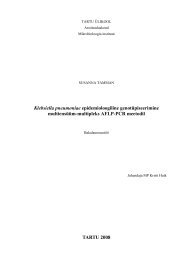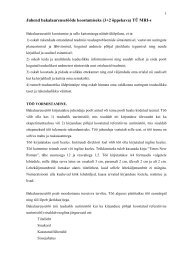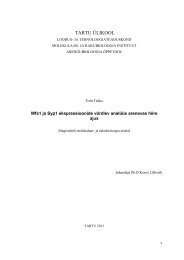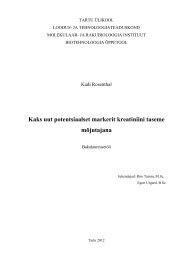Viruses and RNA interference in mammalian cells
Viruses and RNA interference in mammalian cells
Viruses and RNA interference in mammalian cells
Create successful ePaper yourself
Turn your PDF publications into a flip-book with our unique Google optimized e-Paper software.
<strong>RNA</strong>i<br />
The development of biotechnological methods of research <strong>in</strong> the last years made possible<br />
<strong>RNA</strong> <strong><strong>in</strong>terference</strong> to be discovered. <strong>RNA</strong>i is a regulatory mechanism, which silences genes<br />
degrad<strong>in</strong>g m<strong>RNA</strong> <strong>in</strong> a sequence-specific manner with help of small pieces of doublestr<strong>and</strong>ed<br />
<strong>RNA</strong>s: small or short <strong>in</strong>terfer<strong>in</strong>g <strong>RNA</strong>s (si<strong>RNA</strong>s) <strong>and</strong> micro <strong>RNA</strong>s (mi<strong>RNA</strong>s). It<br />
suppresses gene expression at the translation stage or by <strong>in</strong>terfer<strong>in</strong>g the transcription of<br />
specific genes. <strong>RNA</strong>i has been observed <strong>in</strong> organisms as diverse as plants, protozoa,<br />
nematodes, fungi, <strong>in</strong>sects, <strong>and</strong> mammals (Hu et al., 2004). This process takes an <strong>in</strong>tegral part<br />
<strong>in</strong> various eukaryotic functions such as viral defense, chromat<strong>in</strong> remodel<strong>in</strong>g, genome<br />
rearrangement, developmental tim<strong>in</strong>g, bra<strong>in</strong> morphogenesis <strong>and</strong> stem cell ma<strong>in</strong>tenance<br />
(MacRae et al., 2006).<br />
2. <strong>RNA</strong> <strong><strong>in</strong>terference</strong><br />
History of discovery<br />
The history of <strong>RNA</strong>i discovery started when scientists tried to compare the activity of<br />
silenc<strong>in</strong>g of antisense or sense s<strong>in</strong>gle-str<strong>and</strong>ed <strong>RNA</strong>s (ss<strong>RNA</strong>s) with their double-str<strong>and</strong>ed<br />
<strong>RNA</strong> (ds<strong>RNA</strong>) hybrid <strong>in</strong> two types of experiments <strong>in</strong> 1990. First group of experiments was<br />
made to estimate antisense suppression for selective silenc<strong>in</strong>g of plant gene expression. In<br />
theory, antisense <strong>RNA</strong> encoded by a transgene should prevent translation of complementary<br />
m<strong>RNA</strong> of a plant gene <strong>in</strong>to prote<strong>in</strong> by basepair<strong>in</strong>g to it. But the control “sense” transgene<br />
<strong>RNA</strong>s are unable to do it, because they can not basepair to m<strong>RNA</strong>. Hence, the silenc<strong>in</strong>g<br />
should not been observed, but surpris<strong>in</strong>gly it was (Smith et al., 1990). The other type of<br />
experiments, has led to the conclusion that the expression of both <strong>in</strong>troduced <strong>and</strong><br />
homologous endogenous genes <strong>in</strong> petunia leaves was suppressed by <strong>in</strong>troduction of a<br />
pigment-produc<strong>in</strong>g gene that was under a control of a powerful promoter. This phenomenon<br />
scientist called “co-suppression”. It was discovered while scientists made the efforts to<br />
enhance coloration of petunia flowers. They tried to overexpress a transgene that encoded a<br />
prote<strong>in</strong> <strong>in</strong>volved <strong>in</strong> a synthesis of pigments. However, it led to a partial or complete color<br />
loss. That was the result of “co-suppression” or coord<strong>in</strong>ate silenc<strong>in</strong>g (Napoli et al., 1990;<br />
Van der Krol et al., 1990). “Co-suppression” also occurs at the post-transcriptional level.<br />
Such post-transcriptional gene silenc<strong>in</strong>g (PTGS) <strong>in</strong> plants is equivalent of <strong>RNA</strong>i. Posttranscriptional<br />
gene silenc<strong>in</strong>g is a mechanism <strong>in</strong>volv<strong>in</strong>g ds<strong>RNA</strong>, nucleases, small <strong>RNA</strong>s <strong>and</strong><br />
7


